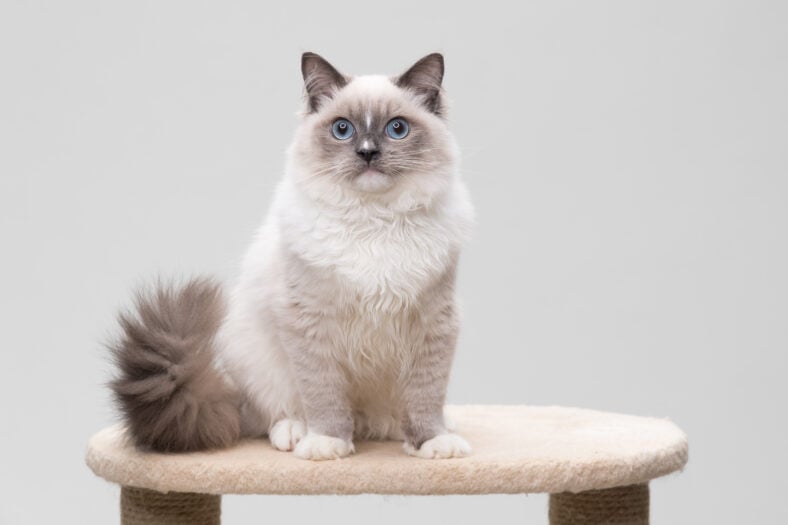Everything You Need To Know About The Ragdoll Cat, A Softy With Plenty Of Playful Quirks

Known for their striking blue eyes, silky coats, and love for cuddles, the ragdoll cat is a big softy with plenty of playful quirks. When being petted, cuddled, or held, this feline sweetheart will go limp with pleasure in your arms.
Ragdolls are very laid-back, so they make a good fit for a variety of homes, particularly ones that are bustling with people and friendly pets. Here’s what you should know about the ragdoll’s care requirements, history, and more.
These cats are notoriously social and have an easygoing personality. They can bond with pretty much anyone. They don’t need a lot of exercise, but getting in enough snuggle time is very important. Ragdolls are one of the largest cat breeds out there, reaching up to 20 pounds and 40 inches long.
They were developed in the 1960s by Ann Baker, who wanted to create a beautiful, elegant cat with an affectionate and loving personality.
She started by breeding a domestic white, long-haired cat with other cats she owned or found. Eventually, she produced the ragdoll. In 1993, the Cat Fanciers Association (CFA) began registering ragdolls.
Ragdolls are relatively easy to care for. They do not require more exercise or grooming than the average cat despite their larger sizes and longer-looking fur. The ragdoll has a silky single coat that is lower-matting than other cats with medium-haired coats.
Still, you should brush this breed at least twice a week to avoid tangles. Since ragdolls don’t have undercoats, they shed less than other breeds.
However, they are not considered hypoallergenic because they produce skin and saliva secretions that people can be allergic to.
Purebred ragdoll kittens are born solid white because of a genetic mutation. Around two months of age, their coats start to develop colors and patterns.

Sign up for Chip Chick’s newsletter and get stories like this delivered to your inbox.
They don’t fully develop until they’re about two years old. Their bodies are also lighter in color than their face, ears, legs, and tail, making them what’s called a “pointed breed.”
Ragdolls are susceptible to some health conditions, including weight issues, bladder stones, and hypertrophic cardiomyopathy.
Your cat’s daily portions of food should be measured out to ensure that they aren’t fed too much. Giving your cat regular playtime with interactive toys will also help keep their weight down.
Bladder stones are very painful for cats and can include blood in the urine. Some signs that your kitty may have bladder stones are vocalizing in the litter box, struggling to urinate, or urinating outside the litter box. Have your cat drink lots of fresh water to avoid bladder stones.
Hypertrophic cardiomyopathy (HCM) is a heart disease that causes the heart muscle to thicken. The condition is genetic and does not have a cure.
If you love the idea of a cuddly, charming cat, then the ragdoll is purrfect for you!
More About:Animals